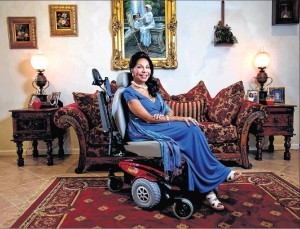More Media & videos available on Youtube
Myra on the “Red Couch”on Youtube
The Palm Beach Post Interviews Myra Goldick regarding “Happiness “
FASCINATING LIVES
‘HAPPINESS is a CHOICE’
Myra Goldick won’t let post-polio syndrome define her. She believes in rising above her challenges — and helping others do so, too.
By Barbara Marshall Palm Beach Post Staff Writer
I’m an expert at tomorrow,” says the unsinkable Myra Goldick, for whom tomorrow hasn’t ever been just another day. That the day after today will be better has been the hope that kept her going at age 10, when all she could move were her eyelids. It’s been the promise that life still holds joy as her body today twists and bends in a slow, painful betrayal, a little-known, late-life legacy of a disease most Americans have forgotten. Polio. Sixty years after she fought her way out of her childhood’s wheelchair, Goldick, 70, must rely on one again because of post-polio syndrome, which strikes some former polio patients 25 to 40 years after the initial infection.
She’s endured years of increasing muscle weakness, atrophy, chronic spinal pain and complicated surgeries. For a time, she thought her spinal degeneration would render her a paraplegic.
The disease’s progression forced her to leave a career she loved as a New York hat designer, after she suffered several severe falls in the company’s warehouse.
Yet, while her ability to move diminishes, her capacity for happiness has not.
The key, she says, is never to ask, “Why me?”
Instead, ponder this question: “Now what?”
One is the lament of a victim; the other the quiet courage of a survivor.
Raising money for book
The buoyant Lake Worth resident is finishing a book she hopes will inspire others to reach beyond their own physical challenges.
“The disabled are the fastest growing minority in the country,” said Goldick. “At first, it can feel like you don’t have a purpose anymore. We have to reinvent ourselves and our dreams.”
She’s trying to raise $7,000 for publication of “Dancing on Our Disabilities: Never Say Impossible to Your Dreams,” through the crowd-source funding site, Indiegogo.
The title came from an evening in a nightclub, where Goldick yearned to dance instead of being sidelined in a wheelchair. She watched a young, wheelchair-bound girl roll up to the dancers and joyfully join in.
Goldick turned to her husband, Neil and said, “Now that’s dancing with your disability.”
Happiness, Goldick has come to believe, is an acquired skill, like learning a foreign language or memorizing physics theorems.
“I realized,” Goldick, said, “how many people are miserable, even without these challenges. I refuse to be. I believe happiness is a choice. If you can’t do one thing, there’s something else that will make you feel alive.”
In her home west of Lake Worth, Goldick is driving her motorized wheelchair as if she’s behind the wheel of a Ferrari.
An adept three-point turn brings her to the dining table, then she buzzes down the hall, making a tight right turn into her office and studio.
She dazzles in a blue maxi-dress with matching shawl, her abundant dark hair pinned up and over one shoulder in a dramatic sweep. Her make-up is glamour girl perfection.
If there was an ad campaign for aging with allure, Goldick could be its face, if not its body.
She’s still the exotic dish who turned her husband, Neil, to jelly when he was a cab-driving student at New York University.
“She got into my cab,” said Neil, “and she was unbelievable.”
That part hasn’t changed.
So much else has.
Paralyzed except for her eyes
Goldick grew up poor and bi-racial in 1950s’ New York City, one of two children of an often-absent, briefly-famous Calypso musician from Trinidad named Sam Manning. To escape pre-war Vienna and move to London, her Austrian mother claimed she was Jewish. Eventually settling in New York, the family lived a hand-to-mouth existence in a welfare apartment with a shared kitchen and bath.
“I was that strange half-breed of a kid, constantly being asked, ‘What are you?’” Goldick remembers.
In the pre-vaccine days of the 1940s and ’50s, summer ushered in terror as polio epidemics swept across the country like a virulent humidity, killing and paralyzing mainly children.
There were 33,000 cases in 1950. A year later, cases had nearly doubled, to 59,000. Until the vaccine, there was little treatment and no cure.
Goldick was 10 the Labor Day weekend of 1953 when she contracted polio, spending 10 days in a coma. When she woke, she was paralyzed except for her eyes. It took three years for her to acquire enough strength to go back to school.
Not surprisingly, she has no patience for those who refuse to immunize their kids against polio.
“Why would you refuse to do the one thing that can protect them against this?” she says, gesturing to her legs.
She learned to walk again, attended the Fashion Institute of Technology, married Neil and had two daughters. She had careers she loved, first as an executive with Flori Roberts, one of the first cosmetics company for women of color. In her 50s, she returned to FIT to earn a degree in millinery, then began working for a major Seventh Avenue hat designer.
If you wore a hat to the Kentucky Derby or Easter services in the 1980s, there’s a good chance Goldick designed it.
But by then, the weakness had begun. She couldn’t control her legs.
‘Happiness is a choice’
The cruel irony of post-polio syndrome is that it strikes at mid-life, just when former childhood polio patients have finally put the horrors of iron lungs and braces behind them.
“It’s almost as if the polio wakes up again to remind patients that it’s still there,” said Dr. Tamar Ference, Assistant Professor of Rehabilitation Medicine at the University of Miami Leonard M. Miller School of Medicine. She directs the center’s post-polio clinic, the only one in South Florida.
Falls become frequent. Decades after re-learning how to use their arms and legs, they’re once again being fit with braces and often require canes and eventually, wheelchairs.
In Goldick’s case, her spine has become so twisted she’s lost more than 3 inches in height. She’s had one complicated surgery to correct her spinal problems and is facing another. Her muscles are atrophying, leaving her too weak to walk more than a few steps. Her hands, with their shrunken muscles, are as delineated as birds’ wings.
Pain has become a daily companion.
But Goldick refuses to dwell on that.
Instead of ticking off a list of what she could no longer do, Goldick moved to Florida in 2003 and investigated what was still possible.
Her wheelchair, she told herself, was just a more comfortable perch from which to work.
Always artistic, she took painting classes and built a reputation as a realist painter. Her portraits, often of glamorous women with perfect, nearly-nude bodies, are sold online.
She joined Toastmasters and gave inspirational talks. Slowly, she became a spokeswoman for disability issues, offering positive encouragement to people struggling with physical and emotional limitations.
A thoroughly modern businesswoman, she has her own web site ( My raGoldick.com ), a Face-book page and regularly sends out uplifting messages to her Twitter followers.
“I began to discover my value in terms of inspiring others,” she says. “Learning that life isn’t just about you takes the focus off what you may be feeling deprived of. Your purpose begins to be more than serving only your personal needs.”
More recently, she’s begun taping a weekly internet radio show called “Never Say Impossible,” to help people unlock their own creativity.
It is possible, she says, to accept your disabilities — she wishes the world would call them challenges — with joy. She directs her message to anyone, but particularly South Florida retirees who are dealing with illness and depression.
Happiness is a choice. Adjust your dreams to your circumstances. Never give up, she directs.
“That is my value, I’ve finally come to realize,” she says. “I hope I can help people who feel abandoned, who feel alone by offering encouragement and support.”
It was the lesson she learned while lying in a hospital bed, at age 10, too paralyzed to wipe away the tears streaming down her face.
“It’s impossible,” she told her doctor. “I’ll never walk again.”
“Young lady,” he told her sternly. “Never say something is impossible.”
It’s been Goldick’s mantra ever since.
“Because once you say something is impossible,” she says, “it is.” [email protected]
Twitter: @Bmarshallpbp
POST-POLIO: THE FACTS
› Post-polio syndrome is not contagious. It affects only polio survivors.
› The number of people with the condition is not known. In the mid-1990s, there were 1 million polio survivors in the US.
› Researchers estimate that the syndrome affects 25 percent to 40 percent of polio survivors.
SOURCE: NATIONAL INSTITUTE OF NEUROLOGICAL
DISORDERS AND STROKE

How Passion and Creativity can change your life on Youtube
Do you think life is fair? Myra say’s “no”, it’s not about fairness on Youtube
Who is Myra anyway? On Youtube
What Happens when you give up? On Youtube
What do you do when the rubber hits the road? On Youtube
How do you get the results you expect from your efforts? On Youtube

